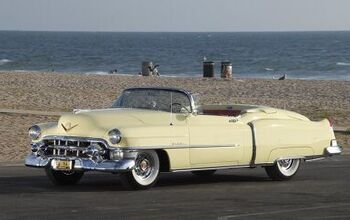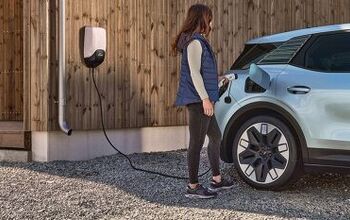Driving Dystopia: Industry Revisiting Vehicle Subscription Services

Despite numerous vehicle subscription services having gone under in recent years, the industry does not seem ready to throw in the towel. In fact, they’re actually appears to be a swelling sense of optimism that the scheme may make a comeback. With the present economic situation making it more difficult for average people to buy new vehicles, some expect vehicle subscriptions to become increasingly popular as cash-strapped drivers become more desperate to replace what’s in the driveway.
For the sake of clarity, we’re discussing vehicle subscriptions where you’re paying to have access to an entire car. While your author is presently working on a rundown of the (egregious) history of in-car subscriptions, where customers are effectively being charged for features that may have otherwise come standard on a car they’ve already purchased, this article is about what effectively boils down to the long-term rental of a vehicle.
You may recall our previous coverage of Book by Cadillac, Audi Select, Ford's Canvas, Access by BMW, Hyundai's Evolve+, the Mercedes-Benz Collection, Car By Volvo, and others. While often little more than regional pilot programs to test the public appetite for vehicle-subscription plans, many went under due to a lack of interest during the pandemic. While subsequent years resulted in record profitability for automakers, 2020 was a bad time to try and normalize a scheme where people effectively rented new vehicles — as most weren’t doing much driving.
However, 2024 has seen a series of marketing agencies revisiting the premise with rose-tinted glasses. Since new cars are already trading at record-setting values and being financed for unprecedented spans of time, the assumption was that some drivers wouldn’t mind opting into what was effectively a premium rental service that gave customers access to a vehicle and the necessary insurance for a monthly fee. If the average American (and European) can no longer afford to buy a new vehicle, perhaps they could just rent them indefinitely.
A YouGov poll form earlier this year offered up some interesting takeaways.
For starters, 33 percent of respondents said they would be interested in trying vehicle subscriptions while 49 percent said they weren’t interested. That leaves a decent number responding without a strong opinion, which makes sense considering 60 percent of those polled said they weren’t really aware of car subscriptions to begin with.
Another study from PwC suggested that the United Kingdom might be even more willing to accept vehicle subscriptions. It claimed that 49 percent of surveyed UK consumers displayed “a lean towards vehicle subscription within the next five years.” It claimed that the interested parties represented cash-strapped people that only needed a vehicle during certain times of the year and drivers interested in consolidating the cost of driving into a single monthly fee. It likewise suggested that automotive subscriptions represented a pathway to the burgeoning electric vehicle (EV) market — which has been undermined by high development costs that have resulted in elevated MSRPs.
But today’s allocation of British vehicles shows that vehicle subscriptions make up roughly 1 percent of all the automobiles currently on that market. They’re not broadly popular. But PwC believes that the industry can “reimagine vehicle ownership” by leveraging their marketing efforts and leveraging key partnerships to make them more appetizing. Sadly, it’s also assumed that they’ll become more popular as true vehicle ownership falls further out of reach for the typical driver.
As a perk, automakers will be able to sidestep any legal issues presented by owners who don’t like their data being harvested. The above would likewise make it easier for manufacturers to lock formerly standard features behind additional paywalls, since they’re technically the ones who own the vehicles. But we’ve seen past attempts creating unnecessary overhead in terms of fleet management and vehicle allocation.
Someone at the company has to maintain these vehicles where they’re not in use and make sure they are delivered/obtained as the rental/subscription agreements dictate. Cadillac stated that this was the primary reason Book went under, although that was supposed to be a more premium service than what some other brands were offering. However, even the most pedestrian variants of these programs (e.g. Sixt or ZipCar) were faulted for lapsing customer service and lackluster quality in terms of the vehicles being offered.
Granted, there’s a difference between car-sharing, rental services, and factory vehicle subscriptions. But they’re all draw from the same pool of customers and are fundamentally similar in the way in which they function as a business. The person spending the money never owns these vehicles, they’re just issued access temporarily in exchange for a nominal fee.
While it may seem like the premise of vehicle subscriptions have already failed, there are actually loads of companies still in operation, particularly in Europe. Flexigo, Drive Fuze, MyCarDirect, EVOGO, Sixt, LeasePlan, and Nissan Subscriptions/FINN all managed to hang in there. But none of them seem to be doing exceptionally well at present and any additions feel like they could easily over-saturate the market.
America has proven itself less inclined to embrace vehicle subscriptions, with traditional rental agencies (and leases) having the U.S. market more-or-less cornered. But that likewise seemed the case before automakers began launching pilot programs in the 2010s. Market analysts are likewise speculating that vehicle inventories will continue to rise, potentially lowering the average transaction price of new models. Why sell for less when you can rent for more and retain ownership of the product you’re “selling?”
With consumers confronting higher costs of living, there may not be sufficient demand for those vehicles. Automakers may again try to tempt drivers into all-inclusive vehicle subscriptions — especially if financing rates remain elevated. But there’s no guarantee that drivers will play along if they become broadly more cash conscious. At the end of the day, the cheapest option is to buy a vehicle and then hold onto it until the repair bills exceed the cost of buying something new. Unless subsequent schemes end up being exceptionally affordable or the general public becomes so destitute that they have no choice but to sign up, vehicle subscriptions are likely to remain a hard sell.
Let’s face it, market analysts and industry leaders were dead wrong about the lucrative nature of automotive subscriptions in the past. There’s no reason to assume they’ll be suddenly right about them this time. At best, the relevant surveys suggest that there’s a subset of the market that’s willing to tolerate the concept of vehicle subscriptions. But the majority of drivers either don’t care or have shown themselves averse to the premise.
[Image: hodim/Shutterstock.com]
Become a TTAC insider. Get the latest news, features, TTAC takes, and everything else that gets to the truth about cars first by subscribing to our newsletter.

Consumer advocate tracking industry trends and regulations. Before joining TTAC, Matt spent a decade working for marketing and research firms based in NYC. Clients included several of the world’s largest automakers, global tire brands, and aftermarket part suppliers. Dissatisfied, he pivoted to writing about cars. Since then, he has become an ardent supporter of the right-to-repair movement, been interviewed about the automotive sector by national broadcasts, participated in a few amateur rallying events, and driven more rental cars than anyone ever should. Handy with a wrench, Matt grew up surrounded by Detroit auto workers and learned to drive by twelve. A contrarian, Matt claims to prefer understeer and motorcycles.
More by Matt Posky
Latest Car Reviews
Read moreLatest Product Reviews
Read moreRecent Comments
- EBFlex Garbage but for less!
- FreedMike I actually had a deal in place for a PHEV - a Mazda CX-90 - but it turned out to be too big to fit comfortably in my garage, thus making too difficult to charge, so I passed. But from that, I learned the Truth About PHEVs - they're a VERY niche product, and probably always be, because their use case is rather nebulous. Yes, you can run on EV power for 25-30 miles, plug it in at home on a slow charger, and the next day, you're ready to go again. Great in theory, but in practice, a) you still need a home charger, b) you paid a LOT more for the car than you would have for a standard hybrid, and c) you discover the nasty secret of PHEVs, which is that when they're on battery power, they're absolute pigs to drive. Meanwhile, to maintain its' piglike battery-only performance, it still needs to be charged, so you're running into all the (overstated) challenges that BEV owners have, with none of the performance that BEV owners like. To quote King George in "Hamilton": " Awesome. Wow." In the Mazda's case, the PHEV tech was used as a performance enhancer - which worked VERY nicely - but it's the only performance-oriented PHEV out there that doesn't have a Mercedes-level pricetag. So who's the ideal owner here? Far as I can tell, it's someone who doesn't mind doing his 25 mile daily commute in a car that's slow as f*ck, but also wants to take the car on long road trips that would be inconvenient in a BEV. Meanwhile, the MPG Uber Alles buyers are VERY cost conscious - thus the MPG Uber Alles thing - and won't be enthusiastic about spending thousands more to get similar mileage to a standard hybrid. That's why the Volt failed. The tech is great for a narrow slice of buyers, but I think the real star of the PHEV revival show is the same tax credits that many BEVs get.
- RHD The speed limit was raised from 62.1 MPH to 68.3 MPH. It's a slight difference which will, more than anything, lower the fines for the guy caught going 140 KPH.
- Msquare The argument for unlimited autobahns has historically been that lane discipline is a life-or-death thing instead of a suggestion. That and marketing cars designed for autobahn speeds gives German automakers an advantage even in places where you can't hope to reach such speeds. Not just because of enforcement, but because of road conditions. An old Honda commercial voiced by Burgess Meredith had an Accord going 110 mph. Burgess said, "At 110 miles per hour, we have found the Accord to be quiet and comfortable. At half that speed, you may find it to be twice as quiet and comfortable." That has sold Mercedes, BMW's and even Volkswagens for decades. The Green Party has been pushing for decades for a 100 km/h blanket limit for environmental reasons, with zero success.
- Varezhka The upcoming mild-hybrid version (aka 500 Ibrida) can't come soon enough. Since the new 500e is based on the old Alfa Mito and Opel Adam platform (now renamed STLA City) you'd have thought they've developed the gas version together.


































Comments
Join the conversation
It's "Care by Volvo" (not Car) and I subscribed. It was a 2 year lease but included insurance, and the ability to trade-in (re-up) for a new model every 12 months. I liked it, but the California New Car Dealer Association killed it with a lawsuit.
I need to see hard pricing and terms to understand if this is a possibility.